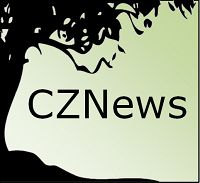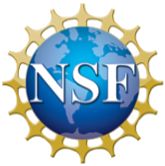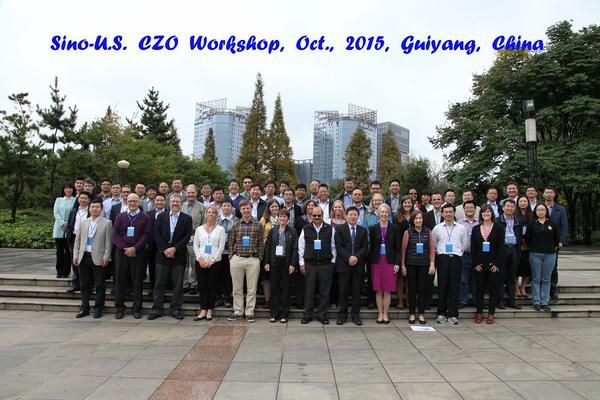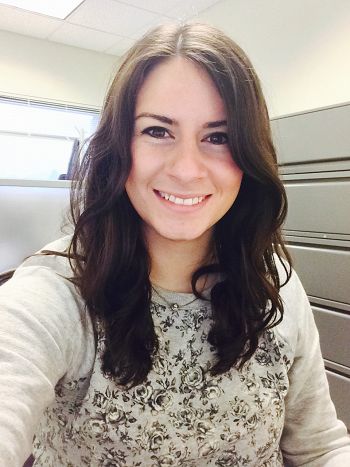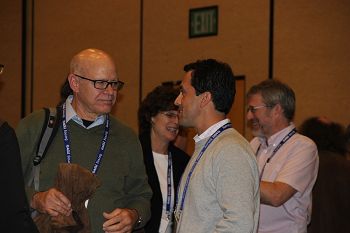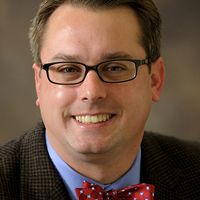CZNews: Winter 2016
Print Verison: CZNews - Winter 2016 (1 MB PDF)
NSF virtual site reviews of CZOs
Richard Yuretich, NSF CZO program director, reported that NSF organized virtual site reviews of each CZO during the months of October, November, and December. The review was conducted by independent panels of distinguished scientists and educators who have been engaged with aspects of critical zone science. The presentations by the sites generated lively discussion among the panelists, and reports for NSF that will be shared with the sites are in progress. The reviews helped to document several scientific achievements that the CZO program has fostered, and identified areas where closer collaboration among the sites will be the most productive. Overall, these reviews will help guide the remaining period of the current Cooperative Agreement and allow for informed discussions of the next phase of critical zone science. The PIs agreed that the virtual review process was a welcome opportunity to articulate progress at each of the sites and to gain constructive feedback from insightful external reviewers. The entire CZO community looks forward to 2016's cross CZO research review, and welcomes input from the wider CZ community as we move forward toward the next ten years. Please send comments to Dr. Tim White (tsw113@psu.edu).
Sino-U.S. CZO Workshop
The National Natural Science Foundation of China (NSFC) and the U.S. National Science Foundation (NSF) jointly convened a workshop to bring together Critical Zone scientists from the two countries to discuss topics of common research interest: 1) networking Critical Zone Observatories in the U.S. and China, and 2) developing a bilaterally coordinated and supported CZ science program. The overall objectives of the proposed bi-national program are to promote CZ science internationally, educate future leaders in global CZ science and policy, and address major societal challenges related to CZ services by leveraging diverse scientific perspectives and unique institutional resources afforded by a more fully integrated U.S.-China initiative. A total of 35 Chinese scientists and 18 U.S. scientists spent two days at the workshop and three additional days in field trips to two CZO sites in China. Representatives from the NSFC and NSF, plus 10 students from the host, the Institute of Geochemistry of the Chinese Academy of Sciences, also attended the workshop and field trips.
Meet our SAVI Staff
We would like to introduce Sarah Sharkey as she begins her second year as staff for the CZO National Office’s Science Across Virtual Institutes (SAVI) project. Sarah graduated from Penn State with a B.S. in Earth Sciences in 2012, and from West Chester University, PA in 2014 with an M.A. in Geoscience. Her graduate research involved a study of unsaturated hydraulic conductivity of serpentinite soils using tension infiltrometry. She is currently working to facilitate communication and cross-site science using common measurements within the U.S CZOs and internationally. She also contributes to CZO communication outlets including CZNews, Twitter and Criticalzone.org.
2016 Events
• Ecosystem Services Workshop: January 25-26, UC Berkeley
• CZO Strategic planning workshop (PIs and NO only): February 3-5, Boulder, CO
• CZO REU/RET Summer Program at Shale Hills CZO & Stroud Water Research Center Deadline: February 15
• CZO SAVI International Scholars Program Deadline: March 7
• CZO SAVI Summer Interns Program Deadline: March 21
• CZO Fall site meeting: September 19-21, Reynolds Creek CZO, ID
• CZO network review: Fall 2016, Arlington, VA
CZO Spotlight: Study predicts bedrock weathering based on topography
A rock outcrop in Gordon Gulch, Colo., with Stephen Martel (University of Hawaii)
pictured in the foreground. Photo: Taylor Perron
In October 2015, James St. Clair (Univ. of Wyoming) and contributing CZO investigators published “Geophysical imaging reveals topographic stress control of bedrock weathering” in the journal Science. Authors report how tectonic stresses interact with topography to influence bedrock weathering. Seismic velocity and electrical resistivity surveys were taken on three landscapes at Boulder Creek and Calhoun CZOs; and Pond Creek, Maryland. Results show the base of the fractured zone mirrors surface topography with a large ratio of horizontal compressive tectonic stresses to near-surface gravitational stresses, and parallels surface topography with a small ratio. Their three-dimensional model, predicting the same results, suggests that tectonic stresses interact with topography to influence bedrock disaggregation, groundwater flow, chemical weathering, and the depth of the critical zone in which many biogeochemical processes occur.
AGU 2015 Fall Meeting
CZ science was well represented at AGU’s 2015 Fall Meeting held December 14-18 in San Francisco, CA. Immediately prior to AGU, an International CZO Workshop supported by the National Office’s SAVI project, gathered 47 scientists representing over 20 countries to discuss science questions being considered by the international CZ community. After an initial session of presentations, participants broke into working groups on potential research projects spanning their field sites and areas of expertise – we will report on the outcome of the workshop in the next newsletter. Community presence at the AGU meeting included our annual booth in the Exhibit Hall, an annual breakfast with NSF, and over 150 posters and presentations related to CZO science. For a list of CZ presentations featured at AGU, view an agenda at /national/news/story/czos-at-agu-2015. The CZO program also engaged the greater research community through a Town Hall where ~70 guests were in attendance. NSF-EAR Division Director Carol Frost gave a short introduction followed by comments made by the CZO National Office. We look forward to AGU 2016!
CUAHSI Organic Matter Short Course
In October 2015, Intensively Managed Landscape (IML) CZO Co-Director, Thanos Papanicolaou, along with IML investigators, Tim Filley, Chris Wilson, and Joshua Peschel, led a CUAHSI Instrument Training Short Course at the Purdue Agronomy Center for Research and Education. Twenty five students from the U.S., Canada, and China, including members of the Catalina-Jemez, Southern Sierra, Reynolds Creek, and IML CZOs, attended the course entitled “The Role of Runoff and Erosion on Soil Carbon Stocks: From Soilscapes to Landscapes” to learn about measurements from the soil profile to the landscape scale that capture the effects of runoff and erosion on soil organic carbon stocks. Students were exposed to state-of-the-art instrumentation used to quantify key indices of four key processes, namely erosion, respiration, litter incorporation into the soil profile, and microbial activity, that define the carbon budget in Intensively Managed Landscapes. These included measuring aggregate stability (photo) and different methods of tracking the movement of litter and soil particles across the landscape and its incorporation into the soil matrix. The students were also exposed to small fixed-wing and quadrotor style unmanned aerial vehicles (UAVs) equipped with sensors currently being used in the IML CZO and planned for use in other CZOs. The short course was run in conjunction with the Critical Zone Science, Sustainability, and Services in a Changing World workshop.
Receive the CZO Email Newsletter
Occasional email will include news, events, and other info related to Critical Zone Observatories.
We hate spam as much as you do, so your information will never be shared. You can unsubscribe at any time.
National Science Foundation
US Sino Workshop
Sarah Sharkey_SAVI
A rock outcrop in Gordon Gulch, Colo., with Stephen Martel (University of Hawaii)
pictured in the foreground. Photo: Taylor Perron
AGU_A_Thompson
Photos: Justin Richardson
CUAHSI Short Course
The Critical Zone. Illustration modified from Chorover, J., R. Kretzschmar, F. Garcia-Pichel, and D. L. Sparks. 2007. Soil biogeochemical processes in the critical zone. Elements 3, 321-326. (artwork by R. Kindlimann). Image Request.
News Category:
RESEARCH |
PUBLICATIONS |
PEOPLE |
EDUCATION/OUTREACH
People Involved
CZO
-
IML, INVESTIGATOR
-
IML, INVESTIGATOR
-
IML, INVESTIGATOR
-
National, Shale Hills, INVESTIGATOR, STAFF
-
IML, INVESTIGATOR
Explore Further
